Neanderthal-inspired ‘minibrains’ hint at what makes modern humans special
by
Elizabeth Pennisi and Robert Gorter, MD, PhD.
Feb. 11th, 2021
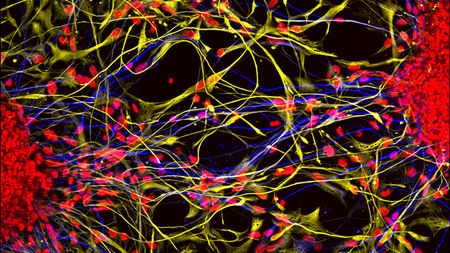
When attached to a plate, brain organoid neurons (yellow) spread out among other cells called astrocytes (blue).(MUOTRI LAB/UNIVERSITY OF CALIFORNIA, SAN DIEGO)
Robert Gorter: when one studies evolutionary biology, one may ask the (philosophical) question: “what was first: the chicken or the egg?” Or, in other words, was there a plan to develop a physical body as we have today (Homo Sapiens) or could/would our body develop of out of an ad random process and at some point, we came out of it as the most adapted creature. One could argue that there was a plan to ultimately, crate the Homo sapiens as we know it and which would bare self-consciousness? Then, we could consider the animal world around us as try-outs to come to a best-possible completion. Evolution has produced astonishing number and variety in insects. Approx. 6 million insects have come into existence. One can get the feeling that early on in evolution, insects were used to intensively “experiment.”
Evolution of insects
The most recent understanding of the evolution of insects is based on studies of the following branches of science: molecular biology, insect morphology, paleontology, insect taxonomy, evolution, embryology, bioinformatics and scientific computing. It is estimated that the class of insects originated on Earth about 480 million years ago, in the Ordovician, at about the same time terrestrial plants appeared. Insects may have evolved from a group of crustaceans. The first insects were land-bound, but about 400 million years ago in the Devonian period one lineage of insects evolved flight, the first animals to do so. The oldest insect fossil has been proposed to be Rhyniognatha hirsti, estimated to be 400 million years old, but the insect identity of the fossil has been contested. Global climate conditions changed several times during the history of Earth, and along with it the diversity of insects. The Pterygotes (winged insects) underwent a major radiation in the Carboniferous (356 to 299 million years ago) while the Endopterygota (insects that go through different life stages with metamorphosis) underwent another major radiation in the Permian (299 to 252 million years ago).
Most extant orders of insects developed during the Permian period. Many of the early groups became extinct during the mass extinction at the Permo-Triassic boundary, the largest extinction event in the history of the Earth, around 252 million years ago. The survivors of this event evolved in the Triassic (252 to 201 million years ago) to what are essentially the modern insect orders that persist to this day. Most modern insect families appeared in the Jurassic (201 to 145 million years ago).
In an important example of co-evolution, a number of highly successful insect groups — especially the Hymenoptera (wasps, bees and ants) and Lepidoptera (butterflies) as well as many types of Diptera (flies) and Coleoptera (beetles) — evolved in conjunction with flowering plants during the Cretaceous (145 to 66 million years ago).
Many modern insect genera developed during the Cenozoic that began about 66 million years ago; insects from this period onwards frequently became preserved in amber, often in perfect condition. Such specimens are easily compared with modern species, and most of them are members of extant genera.
Evolutionary biology is the subfield of biology that studies the evolutionary processes (natural selection, common descent, and speciation) that produced the diversity of life on Earth. In the 1930s, the discipline of evolutionary biology emerged through what Julian Huxley called the modern synthesis of understanding, from previously unrelated fields of biological research, such as genetics and ecology, systematics and paleontology.
The investigational range of current research widened to encompass the genetic architecture of adaptation, molecular evolution, and the different forces that contribute to evolution, such as sexual selection, genetic drift, and biogeography. Moreover, the newer field of evolutionary developmental biology (“evo-devo”) investigates how embryogenesis, the development of the embryo, is controlled, thus yielding a wider synthesis that integrates developmental biology with the fields of study covered by the earlier evolutionary synthesis.
Evolution is the central unifying concept in biology. Biology can be divided in various ways. One way is by the level of biological organization, from molecular to cell, organism to population. An earlier way is by perceived taxonomic group, with fields such as zoology, botany, and microbiology, reflecting what were once seen as the major divisions of life. A third way is by approach, such as field biology, theoretical biology, experimental evolution, and paleontology. These alternative ways of dividing up the subject can be combined with evolutionary biology to create subfields like evolutionary ecology and evolutionary developmental biology.
More recently, the merge between the biological science and applied sciences gave birth to new fields that are extensions of evolutionary biology, including evolutionary robotics, engineering,[1] algorithms,[2] economics,[3] and architecture.[4] The basic mechanisms of evolution are applied directly or indirectly to come up with novel designs or solve problems that are difficult to solve otherwise. The research generated in these applied fields in turn contribute to progress, especially thanks to work on evolution in computer science and engineering fields such as mechanical engineering.[5]
What is it about DNA that makes the human brain “human?” Seeking to understand how our complex brains evolved, researchers have now switched a single human gene out for its Neanderthal counterpart in brain tissue grown in a lab dish. Changes to the resulting organoid reveal the role this gene may have played in ancient—and modern—brain development.
“This is amongst the first studies of its kind to investigate how specific changes in the DNA of modern humans influences brain development,” says Debra Silver, a developmental neurobiologist at Duke University who was not involved with the work. Although past work has used similar approaches to examine the differences between the brains of humans and other primates, the new work looks at an even closer relative, where differences are expected to be more subtle.
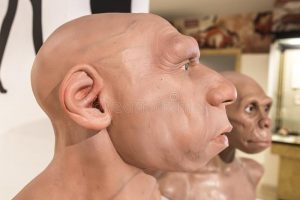
Reconstruction of a Neanderthal male
Neanderthals are archaic humans that lived from 500,000 years ago to about 11,700 years ago, interbreeding with our species, Homo sapiens, for much of that time. Their brains were about as big as ours, but anthropologists think they must have worked incredibly differently, because in those hundreds of thousands of years, Neanderthals never achieved the sophisticated technology and artistry humans have.
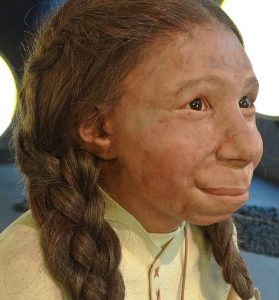
Reconstruction Neanderthal female (Museum on Neanderthal in Germany)
To explore what differences might exist, neuroscientist Alysson Muotri at the University of California, San Diego (UCSD), and his team first compared the genomes of modern humans with those of Neanderthals and Denisovans -another archaic human- reconstructed from excavated bones. They found 61 genes for which modern humans all had one version and the archaic humans had another.
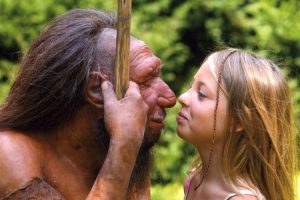
Reconstruction to express the differences between a Neanderthal and a current human (Neanderthal Museum Germany)
His team then used the gene-editing tool CRISPR on stem cells derived from human skin cells to modify a gene, NOVA1, known to regulate the activity of other genes during early brain development. Switching out just one DNA base turned that gene into a Neanderthal NOVA1. Next, the researchers grew little clusters of brain cells called organoids, with and without the Neanderthal version, and compared them. Organoids are a far cry from real brains, and those with a single Neanderthal gene can by no means be considered fully “Neanderthal” organoids, cautions Madeline Lancaster, a developmental biologist at the Medical Research Council’s Laboratory of Molecular Biology.
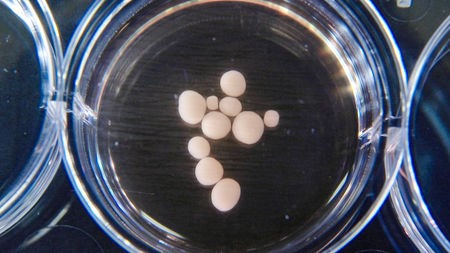
These brain organoids carry a Neanderthal gene. (MUOTRI LAB/UNIVERSITY OF CALIFORNIA, SAN DIEGO)
Nonetheless, changing that one gene altered the organoid’s growth, appearance, and electrical activity, Muotri and his colleagues report today in Science (February 2021). The modified organoid matured faster, yielding an uneven, complex surface instead of a smooth one. Its electrical activity revved up more quickly than that of its counterpart, and the connections between nerves, the synapses, depended on slightly different versions and interactions of key proteins. What’s more, the electrical impulses were not as synchronized as in the fully modern human organoid. “It looks almost like anything they could [test] showed a difference,” says Arnold Kriegstein, a developmental neurobiologist at the UC San Francisco School of Medicine (UCSF).
The results, which held up in tests using human stem cells derived from a different donor’s skin cells, “tell us their brains probably worked in a different way than [ours] do,” Muotri says.
Researchers are excited but cautious about these results. “It is amazing that by changing a single amino acid in a single protein, one creates an effect that is visible even in how the organoids look in the microscope,” says Svante Pääbo, director of the Max Planck Institute for Evolutionary Anthropology. But because organoids represent only the earliest stages of development, “it’s difficult to know how [the changes] would manifest in a more mature brain,” Kriegstein says.
Although they can be powerful, organoids “are a difficult tool,” adds Wolfgang Enard, an evolutionary geneticist at Ludwig Maximilian University of Munich. They can be tricky to grow and their characteristics are often hard to replicate across batches.
But Muotri is undaunted. Now that they have the protocol nailed down, he and other UC San Diego researchers have launched a center to expand their study of archaic human gene variants. Having teased out the effects of one Neanderthal gene, they’re ready to tackle the other 60.
References:
- “Evolutionary engineering”. Archived from the original on 16 December 2016.
- “What is an Evolutionary Algorithm?” (PDF). Archived (PDF) from the original on 9 August 2017.
- “What economists can learn from evolutionary theorists”. Archived from the original on 30 July 2017.
- “Investigating architecture and design”. 24 February 2009. Archived from the original on 18 August 2017.
- Introduction to Evolutionary Computing: A.E. Eiben. Natural Computing Series. Springer. 2003. ISBN 9783642072857. Archived from the original on 1 September 2017.
biology.creighton.edu